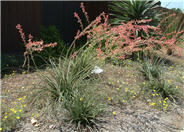
Common name:Red Yucca
Botanical name:Hesperaloe parviflora
This spectacular succulent is wonderful for a desert garden, with rosettes of gray green leaves to about 3'-4' tall and 6' wide. Red flower stalks emerge during spring and remain on the plant until the end of summer. This shrub will spread to form a crowded grass-like clump. This evergreen shrub is drought resistant but will appear better and bloom longer with added moisture. It does well in full sun, reflected heat, poor soils and cold temperatures to at least 0 degrees F.

Common name:Our Lord's Candle
Botanical name:Hesperoyucca whipplei
Stemless, it produces dense clusters of rigid, gray green leaves 12"-18" long. Its drooping, bell-shaped flowers appear on large, branched spikes 3'-6' long. Plants die after blooming, much like Agaves, but only individual rosettes will die off; others in clump will continue to live and eventually bloom. Overall plant grows 3' tall and 6' wide. This CA native prefers well drained soil and is drought tolerant but will lose lower leaves with extended drought..

Common name:Violet Pad Opuntia
Botanical name:Opuntia macrocentra 'Tubac'
Opuntia violacea santa-rita is a cacti. Though perfectly hardy in the coldest winters, they need perfect drainage to survive winter freezes and thaws. It does well when grown in raised beds.

Common name:Century Plant, Maguey
Botanical name:Agave americana
This plant is fast growing to about 6'-10' tall and 8'-13' wide. Wide gray leaves have stiff terminal spines and recurved teeth on margins. It prefers full sun and well-drained situations. After blooming, which could take several years, it will die but will send up new pups from around the base. Some people are allergic to the sap. Removal is difficult if unwanted.
| Designer: Los Angeles Arboretum | Desert Scene |
Photographer: GardenSoft |
Soils and Compost:
Incorporate compost 6" into your soil to retain water, reduce compaction, feed earthworms, and provide valuable nutrients to your plants.
Water Saving Tip:
Apply as little fertilizer as possible.
If you use fertilizer make sure it stays on the landscape, and carefully water it in so there is NO runoff.
Integrated Pest Management:
Remove irrigation water and fertilizer from areas where you don't want weeds to grow.
